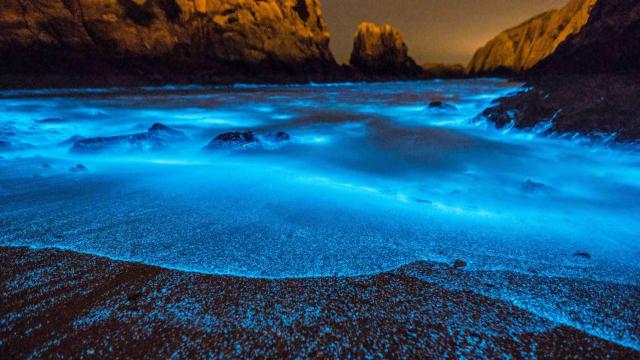Satellite imagery taken over the past two decades shows that the toxic bioluminescent microorganisms responsible for China’s sparkling blue seas are becoming increasingly abundant.
New research published in Geophysical Research Letters is the first to use satellite data to track algal blooms consisting of red Noctiluca scintillans (RNS), a single-celled microorganism that produces the beautiful bioluminescent blue glow known as “blue tears.” These tiny sea creatures prefer coastal waters, especially along the coast of the East China Sea where they appear in the numbers required to produce the spectacular blue glow.
Also known as sea sparkles, red Noctiluca scintillans are contributors to red tides—deadly algal blooms that are toxic to marine life. Excessive algae can also starve water of its oxygen, creating noxious dead zones. At the same time, however, RNS are important to ocean ecosystems, as they feed on other phytoplankton and zooplankton.
Accordingly, marine biologists would very much like to track the dynamic ebbs and flows of red Noctiluca scintillans, but it’s not easy. The size of these blooms changes dramatically depending on the season, and their ephemeral, transient nature makes them notoriously difficult to detect and monitor. Biologists have tried to track RNS blooms using boats, but these efforts have largely failed to show distribution patterns over large areas.
The new study, led by Lin Qi, an optical oceanographer at Sun Yat-Sen University in China, is now the first to use satellites to track RNS blooms. As the study shows, these microorganisms can be found farther from the coast and in warmer waters than previously thought. Perhaps more importantly, however, the new study suggests these glowing blue sea creatures have become more abundant in recent years.
The researchers were able to detect RNS blooms due to the unique way this plankton absorbs and scatters light. Compared to other algae, their tiny bodies absorb more blue light and scatter more red light.
For the study, the scientists looked at nearly 1,000 images of the East China Sea captured by NASA’s Terra and Aqua satellites and the International Space Station from 2000 to 2017. From these images, the researchers were able to detect the distinctive red RNS blooms, as distinguished from other species of algae.
The resulting analysis revealed distinctive seasonal patterns in terms of growth, most notably the observation that RNS blooms peak from April to August. These microorganisms were also found farther from shore than ever before—in some cases as far as 300 kilometers (180 miles) offshore. Additionally, RNS were found in warm waters not typically known to harbour the species; RNS are normally seen in waters around 20 to 25 degrees Celsius, but the new study shows they can live and thrive in waters at 28 degrees Celsius. Taken together, these observations expand the known habitat of red Noctiluca scintillans.
The size of RNS blooms varied each year, but a general growth trend was observed over the 18-year period studied, especially between 2013 and 2017. The researchers detected a particularly prolonged bloom in 2017, which lasted from mid-April to mid-July. As to the cause, the researchers attributed it to excessive nutrient runoff from farms in China due to the increased use of fertilisers.
Interestingly and upsettingly, a similar thing is happening in the Gulf of Mexico. The researchers would like to make more observations over the coming years to confirm this apparent growth trend in the East China Sea.
Importantly, the analysis also showed a decrease in RNS blooms in 2000, which the researchers attributed to the construction of China’s Three Gorges Dam. A press release from the American Geophysical Union explains:
The dam spans the Yangtze River in eastern China and generates roughly the amount of energy as 12 nuclear reactors. The dam has been controversial since Chinese leaders first proposed it because of its impacts on the environment and its displacement of more than a million local residents.
Construction on the dam began in 1994 and was completed in 2006; the dam became fully operational in 2012. Water flow on the Yangtze River dramatically decreased during construction, but once the dam was filled and became operational, the flow rebounded. The Yangtze River empties into the East China Sea and red Noctiluca scintillans blooms are often found near the river’s mouth, so the authors suspect the reduced river flow during the dam’s construction reduced red Noctiluca scintillans blooms from 2000 to 2003.
A deeper understanding of how RNS blooms grow and spread in the East China Sea is obviously important given the ecological value of this species, and its potential to wreak havoc as a contributing organism to red tides. That said, this research could also be a boon to tourism.
As the AGU post pointed out, the new satellite monitoring technique could be used by local officials to pinpoint the location of RNS blooms, allowing them to alert tourists to the presence of the blue tears. In turn, tourists would know the best times and places to view this remarkable spectacle.
Sigh. It’s a shame that so many of the best things in life, when in excess, become poison.
